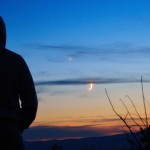
Moonlight to obscure 2015 May Eta Aquarid meteor shower

Draw an imaginary line from Jupiter and past Venus to locate Mercury near the horizon. The planets are always found near the ecliptic – Earth’s orbital plane projected onto the constellations of the Zodiac. Read more
Evening planets in May 2015
Brilliant Venus in west from dusk until late evening
Fading Mars lost in the glare of sunset
Bright Jupiter from dusk until late night
Saturn from nightfall until dawn
Mercury at dusk, sets around nightfall
Morning planets in May 2015
Bright Jupiter out until after midnight
Saturn from nightfall until dawn
Enjoying EarthSky so far? Sign up for our free daily newsletter today!
Brilliant Venus in west from dusk until late evening. Venus – the brightest planet and third-brightest celestial luminary overall (after the sun and moon) – climbs higher up at sunset, and stays out later after dark, than it did in April 2015. In the Northern Hemisphere, Venus stays out until late evening, and in the Southern Hemisphere, Venus sets by mid-evening.
Throughout May 2015, brilliant Venus beams like a lighthouse as darkness falls! At mid-northern latitudes, Venus stays out quite late, possibly after your bedtime. Be sure to catch the wonderful presence of the moon in Venus’ vicinity for several days, centered on May 21.
At mid-northern latitudes, this dazzling world sets about three and one-half hours after sunset all month long. At temperate latitudes in the Southern Hemisphere, the queen planet’s visibility improves throughout May, setting about two and one-half hours after the sun in early May, and three hours after the sun by the month’s end. From either the Northern or Southern Hemisphere, Venus – the brightest star-like object in all the heavens – totally predominates over the western sky as darkness falls.
Enjoying EarthSky so far? Sign up for our free daily newsletter today!
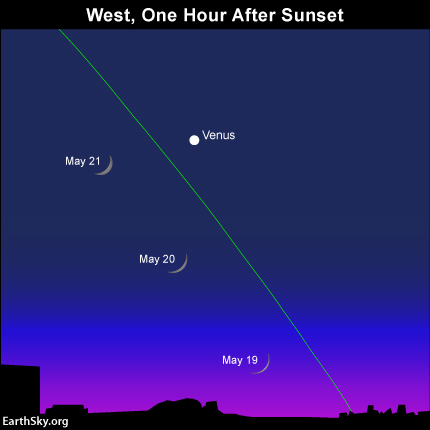
View the crescent moon with Venus for several days, centered on May 21. Up for a big challenge? Try to catch the young moon returning to the evening sky on May 19.
Fading Mars lost in the glare of sunset. Mars has lingered in our western twilight sky for many months, and it continues to fade in brightness, falling into the sunset glare. It sinks farther and farther below Venus each evening. Most likely, you won’t see Mars at all this month. Mars follows the sun below the horizon a very short while after sundown.
Why is the Red Planet getting dimmer and dropping into the sunset now? It’s because Mars is now lagging far behind Earth in its larger and slower orbit. Soon, Earth will be so far ahead of Mars in orbit that the sun will be between us and it. Mars will pass behind the sun, thereby entering our morning sky, on June 14. But we won’t see much of Mars between now and June. The bright glare of the sunset will hide it from our view long before its June conjunction with the sun.
Like a fading ember, this world is slowly but surely disappearing into the glow of sunset this month, as our planet Earth races ahead of Mars in its orbit.

Watch for the waxing crescent moon to pass close to Jupiter on May 22, May 23 and May 24. The green line depicts the ecliptic – Earth’s orbital plane projected onto the tarry sky. Read more.
Bright Jupiter from dusk until late night. Once you see Jupiter at dusk or nightfall, you won’t mistake it for anything else – except, possibly, brighter Venus, which shines lower down than Jupiter.
Jupiter shines more brilliantly than any star. It’s the second-brightest planet after Venus. In May 2015, Venus sets in the west at mid-to-late evening, leaving the king planet Jupiter to rule the night for a few to several hours after Venus sets. Jupiter goes westward throughout the night. At mid-northern latitudes, Jupiter sets in the west about an hour after the midnight hour (roughly 2 a.m. daylight-saving time), and by the month’s end, the queen planet sets around midnight (roughly 1 a.m. daylight-saving time).
Watch the moon pass close to Jupiter on the evenings of May 22 and May 23 and May 24.
If you have binoculars or a telescope, be sure to check out Jupiter’s four major moons, which look like pinpricks of light on or near the same plane. They are often called the Galilean moons to honor Galileo, who discovered these great Jovian moons in 1610. In their order from Jupiter, these moons are Io, Europa, Ganymede and Callisto.
These moons circle Jupiter around the Jovian equator. In cycles of six years, we view Jupiter’s equator edge-on. So, in 2015, we get to view a number of mutual events involving Jupiter’s moons through a high-powered telescope. Click here or here or here for more details.
Click here for a Jupiter’s moons almanac, courtesy of Sky & Telescope.
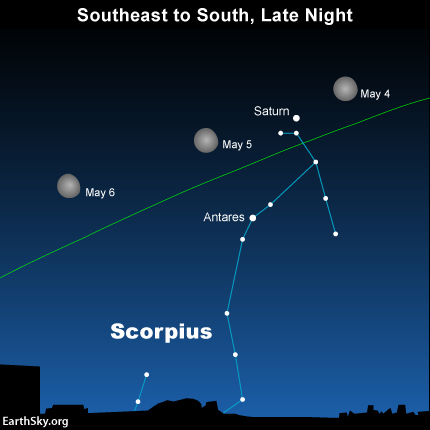
Look for the bright waning gibbous moon near the planet Saturn on May 4 and May 5. The green line depicts the ecliptic – the sun’s annual path in front of the backdrop stars.
Saturn from nightfall until dawn. At mid-northern latitudes, the golden planet Saturn rises in the southeast around nightfall in early May and is out as soon as darkness falls by the month’s end. The same holds true for the Southern Hemisphere. Saturn reaches a big milestone this month as the ringed planet reaches opposition on May 23!
Saturn closest for 2015 on May 22-23
At opposition, our planet Earth swings in between Saturn and the sun. Because Saturn resides opposite the sun in Earth’s sky at this juncture, Saturn rises in the east around sunset. This golden world climbs highest up in the sky at midnight and then sets in the west around sunrise. In other words, Saturn shines all night long, from dusk till dawn!
Watch for the bright moon to shine fairly close to Saturn for several days, centered around May 4.
Binoculars don’t reveal Saturn’s gorgeous rings. For that, you need a small telescope.
Saturn’s rings are inclined at nearly 25o from edge-on in May 2015, exhibiting their northern face. Several years from now, in October 2017, the rings will open most widely, displaying a maximum inclination of 27o. As with so much in space (and on Earth), the appearance of Saturn’s rings from Earth is cyclical. In the year 2025, the rings will appear edge-on as seen from Earth. After that, we’ll begin to see the south side of Saturn’s rings, to increase to a maximum inclination of 27o by May 2032.
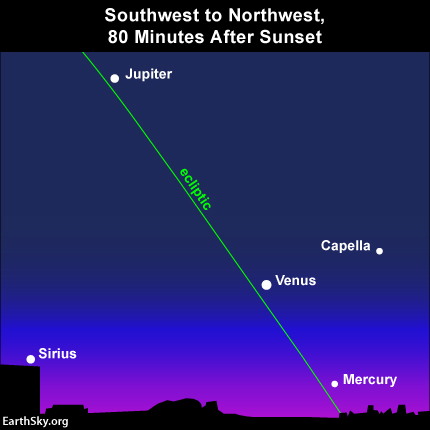
Draw an imaginary line from Jupiter and past Venus to locate Mercury near the horizon. The green line depicts the ecliptic – Earth’s orbital plane projected onto the dome of sky.
Mercury at dusk, sets around nightfall. Mercury is our solar system’s innermost planet and always stays near the sun in our sky. As seen from the Northern Hemisphere, the first few weeks of May 2015 present the best time this year to catch Mercury in the evening sky. Mercury reaches its greatest evening elongation from the sun on May 7 (or May 6, depending on your time zone).
Those at southerly latitudes aren’t quite as lucky this month. As seen from there, the ecliptic – or path of the planets – makes a narrower angle to the evening horizon, so Mercury is more deeply buried in the glare of evening twilight. Try scanning with binoculars, if you’re in a Southern Hemisphere location.
At temperate latitudes in the Northern Hemisphere, this world sets nearly two hours hours after the sun in early May. Look for Mercury over the sunset point on the horizon as dusk gives way to darkness.
Or try this. Draw an imaginary line from bright Jupiter through even-brighter Venus to locate Mercury near the horizon, starting around 60 to 75 minutes after sunset. What is that line across the sky? It’s the ecliptic – the sun’s annual path and the moon’s monthly path – in front of the constellations of the Zodiac. The ecliptic marks the approximate plane of the solar system, because the planets circle the sun on nearly the same plane that Earth does.
Binoculars are always recommended to enhance sky views! Click here for recommended almanacs. They can help you know when Mercury sets in your sky.
Mercury will stay in the evening sky until nearly the end of May 2015. Then it’ll pass into the morning sky, to give the Southern Hemisphere a favorable morning apparition of Mercury in the second half of June 2015.
Distances of the planets from the sun
What do we mean by visible planet? By visible planet, we mean any solar system planet that is easily visible without an optical aid and that has been watched by our ancestors since time immemorial. In their outward order from the sun, the five visible planets are Mercury, Venus, Mars, Jupiter and Saturn. These planets are visible in our sky because their disks reflect sunlight, and these relatively nearby worlds tend to shine with a steadier light than the distant, twinkling stars. They tend to be bright! You can spot them, and come to know them as faithful friends, if you try.
Bottom line: Three of the five visible planets are in good view in the evening sky throughout May 2015: Venus, Jupiter shine first thing at dusk, and Saturn rises into the sky by nightfall. For the Northern Hemisphere, Mercury features its best evening apparition of the year.
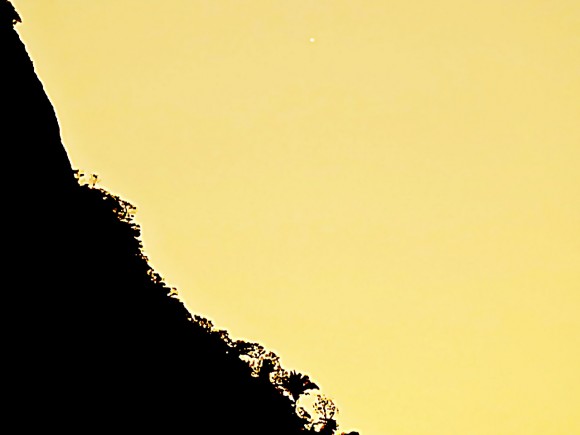
View larger.| Venus near the setting sun on November 18, 2014 by Helio de Carvalho Vital in Rio de Janeiro, Brazil. He wrote, “I managed to capture Venus as it is starting its return to dusk, despite the fact that it is still at a mere 6.2° distance from the sun. The photos show it a few minutes before setting behind the northern side of the 1,021-meter high Tijuca Peak, located some 6.5 km away. It was deeply immersed in the intense glare of the sun, that would set some 13 minutes later.”
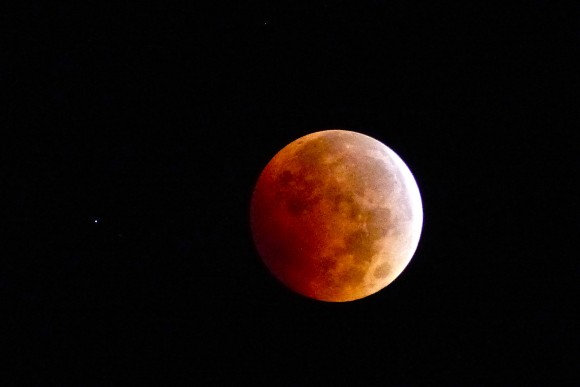
Lunar eclipse on the night of October 8, 2014. The object to the left is the planet Uranus! This beautiful photo is by Janey Wing Kenyon of Story, Wyoming.
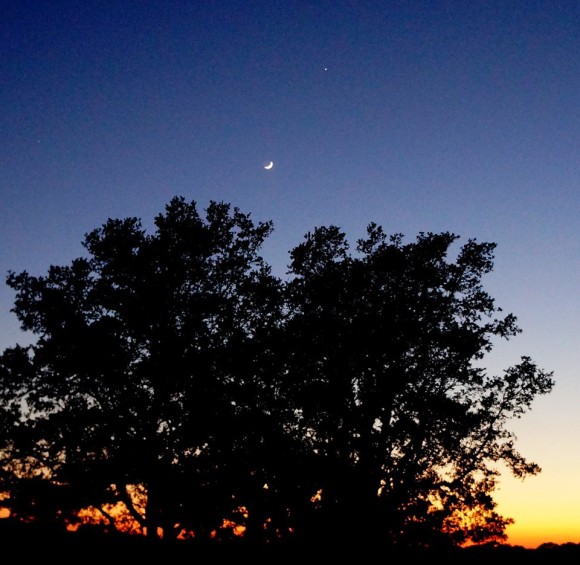
Debra Fryar in Calobreves, Texas captured this photo of the moon and Jupiter on May 31, 2014. Jupiter was close to the twilight then.
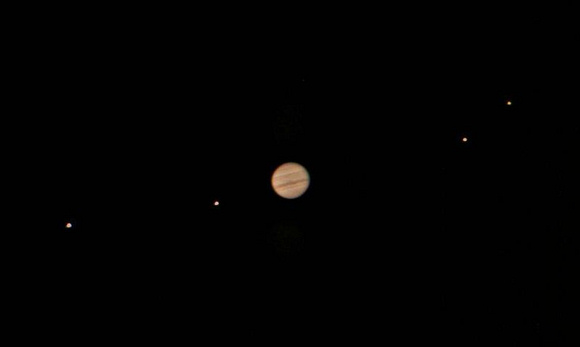
With only a modest backyard telescope, you can easily see Jupiter’s four largest moons. Here they are through a 10″ (25 cm) Meade LX200 telescope. Image credit: Jan Sandberg
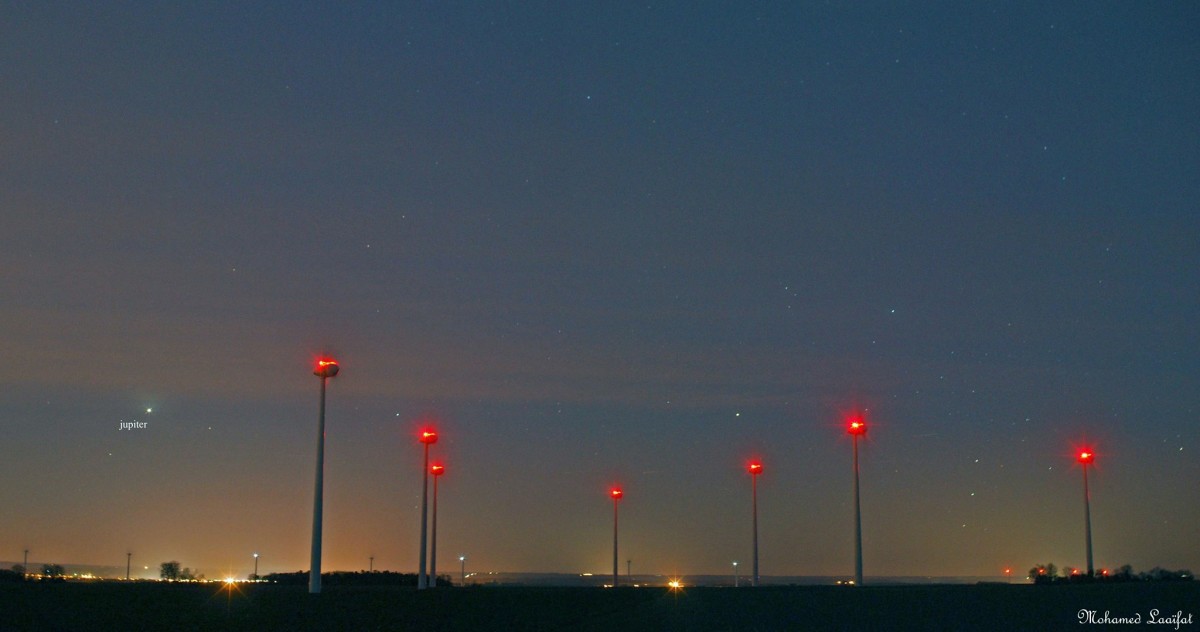
Jupiter was rivaling the streetlights, when Mohamed Laaifat Photographies captured this photo in Normandy, France. Visit his page on Facebook.

Venus by Danny Crocker-Jensen
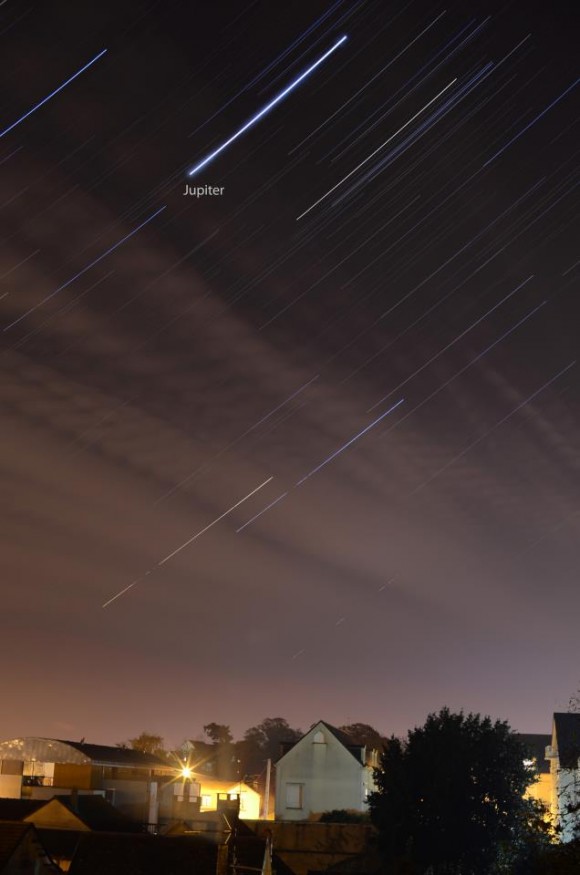
These are called star trails. It’s a long-exposure photo, which shows you how Earth is turning under the stars. The brightest object here is Jupiter, which is the second-brightest planet, after Venus. This awesome photo by EarthSky Facebook friend Mohamed Laaifat in Normandy, France. Thank you, Mohamed.

View larger. | Mercury, Venus and Jupiter seen when evening fell in Hong Kong on June 1, 2013. Photo by EarthSky Facebook friend Matthew Chin. Awesome shot, Matthew!

Skywatcher, by Predrag Agatonovic.
Easily locate stars and constellations with EarthSky’s planisphere.
Don’t miss anything. Subscribe to EarthSky News by email
from EarthSky http://ift.tt/IJfHCr

Moonlight to obscure 2015 May Eta Aquarid meteor shower

Draw an imaginary line from Jupiter and past Venus to locate Mercury near the horizon. The planets are always found near the ecliptic – Earth’s orbital plane projected onto the constellations of the Zodiac. Read more
Evening planets in May 2015
Brilliant Venus in west from dusk until late evening
Fading Mars lost in the glare of sunset
Bright Jupiter from dusk until late night
Saturn from nightfall until dawn
Mercury at dusk, sets around nightfall
Morning planets in May 2015
Bright Jupiter out until after midnight
Saturn from nightfall until dawn
Enjoying EarthSky so far? Sign up for our free daily newsletter today!
Brilliant Venus in west from dusk until late evening. Venus – the brightest planet and third-brightest celestial luminary overall (after the sun and moon) – climbs higher up at sunset, and stays out later after dark, than it did in April 2015. In the Northern Hemisphere, Venus stays out until late evening, and in the Southern Hemisphere, Venus sets by mid-evening.
Throughout May 2015, brilliant Venus beams like a lighthouse as darkness falls! At mid-northern latitudes, Venus stays out quite late, possibly after your bedtime. Be sure to catch the wonderful presence of the moon in Venus’ vicinity for several days, centered on May 21.
At mid-northern latitudes, this dazzling world sets about three and one-half hours after sunset all month long. At temperate latitudes in the Southern Hemisphere, the queen planet’s visibility improves throughout May, setting about two and one-half hours after the sun in early May, and three hours after the sun by the month’s end. From either the Northern or Southern Hemisphere, Venus – the brightest star-like object in all the heavens – totally predominates over the western sky as darkness falls.
Enjoying EarthSky so far? Sign up for our free daily newsletter today!

View the crescent moon with Venus for several days, centered on May 21. Up for a big challenge? Try to catch the young moon returning to the evening sky on May 19.
Fading Mars lost in the glare of sunset. Mars has lingered in our western twilight sky for many months, and it continues to fade in brightness, falling into the sunset glare. It sinks farther and farther below Venus each evening. Most likely, you won’t see Mars at all this month. Mars follows the sun below the horizon a very short while after sundown.
Why is the Red Planet getting dimmer and dropping into the sunset now? It’s because Mars is now lagging far behind Earth in its larger and slower orbit. Soon, Earth will be so far ahead of Mars in orbit that the sun will be between us and it. Mars will pass behind the sun, thereby entering our morning sky, on June 14. But we won’t see much of Mars between now and June. The bright glare of the sunset will hide it from our view long before its June conjunction with the sun.
Like a fading ember, this world is slowly but surely disappearing into the glow of sunset this month, as our planet Earth races ahead of Mars in its orbit.

Watch for the waxing crescent moon to pass close to Jupiter on May 22, May 23 and May 24. The green line depicts the ecliptic – Earth’s orbital plane projected onto the tarry sky. Read more.
Bright Jupiter from dusk until late night. Once you see Jupiter at dusk or nightfall, you won’t mistake it for anything else – except, possibly, brighter Venus, which shines lower down than Jupiter.
Jupiter shines more brilliantly than any star. It’s the second-brightest planet after Venus. In May 2015, Venus sets in the west at mid-to-late evening, leaving the king planet Jupiter to rule the night for a few to several hours after Venus sets. Jupiter goes westward throughout the night. At mid-northern latitudes, Jupiter sets in the west about an hour after the midnight hour (roughly 2 a.m. daylight-saving time), and by the month’s end, the queen planet sets around midnight (roughly 1 a.m. daylight-saving time).
Watch the moon pass close to Jupiter on the evenings of May 22 and May 23 and May 24.
If you have binoculars or a telescope, be sure to check out Jupiter’s four major moons, which look like pinpricks of light on or near the same plane. They are often called the Galilean moons to honor Galileo, who discovered these great Jovian moons in 1610. In their order from Jupiter, these moons are Io, Europa, Ganymede and Callisto.
These moons circle Jupiter around the Jovian equator. In cycles of six years, we view Jupiter’s equator edge-on. So, in 2015, we get to view a number of mutual events involving Jupiter’s moons through a high-powered telescope. Click here or here or here for more details.
Click here for a Jupiter’s moons almanac, courtesy of Sky & Telescope.

Look for the bright waning gibbous moon near the planet Saturn on May 4 and May 5. The green line depicts the ecliptic – the sun’s annual path in front of the backdrop stars.
Saturn from nightfall until dawn. At mid-northern latitudes, the golden planet Saturn rises in the southeast around nightfall in early May and is out as soon as darkness falls by the month’s end. The same holds true for the Southern Hemisphere. Saturn reaches a big milestone this month as the ringed planet reaches opposition on May 23!
Saturn closest for 2015 on May 22-23
At opposition, our planet Earth swings in between Saturn and the sun. Because Saturn resides opposite the sun in Earth’s sky at this juncture, Saturn rises in the east around sunset. This golden world climbs highest up in the sky at midnight and then sets in the west around sunrise. In other words, Saturn shines all night long, from dusk till dawn!
Watch for the bright moon to shine fairly close to Saturn for several days, centered around May 4.
Binoculars don’t reveal Saturn’s gorgeous rings. For that, you need a small telescope.
Saturn’s rings are inclined at nearly 25o from edge-on in May 2015, exhibiting their northern face. Several years from now, in October 2017, the rings will open most widely, displaying a maximum inclination of 27o. As with so much in space (and on Earth), the appearance of Saturn’s rings from Earth is cyclical. In the year 2025, the rings will appear edge-on as seen from Earth. After that, we’ll begin to see the south side of Saturn’s rings, to increase to a maximum inclination of 27o by May 2032.

Draw an imaginary line from Jupiter and past Venus to locate Mercury near the horizon. The green line depicts the ecliptic – Earth’s orbital plane projected onto the dome of sky.
Mercury at dusk, sets around nightfall. Mercury is our solar system’s innermost planet and always stays near the sun in our sky. As seen from the Northern Hemisphere, the first few weeks of May 2015 present the best time this year to catch Mercury in the evening sky. Mercury reaches its greatest evening elongation from the sun on May 7 (or May 6, depending on your time zone).
Those at southerly latitudes aren’t quite as lucky this month. As seen from there, the ecliptic – or path of the planets – makes a narrower angle to the evening horizon, so Mercury is more deeply buried in the glare of evening twilight. Try scanning with binoculars, if you’re in a Southern Hemisphere location.
At temperate latitudes in the Northern Hemisphere, this world sets nearly two hours hours after the sun in early May. Look for Mercury over the sunset point on the horizon as dusk gives way to darkness.
Or try this. Draw an imaginary line from bright Jupiter through even-brighter Venus to locate Mercury near the horizon, starting around 60 to 75 minutes after sunset. What is that line across the sky? It’s the ecliptic – the sun’s annual path and the moon’s monthly path – in front of the constellations of the Zodiac. The ecliptic marks the approximate plane of the solar system, because the planets circle the sun on nearly the same plane that Earth does.
Binoculars are always recommended to enhance sky views! Click here for recommended almanacs. They can help you know when Mercury sets in your sky.
Mercury will stay in the evening sky until nearly the end of May 2015. Then it’ll pass into the morning sky, to give the Southern Hemisphere a favorable morning apparition of Mercury in the second half of June 2015.
Distances of the planets from the sun
What do we mean by visible planet? By visible planet, we mean any solar system planet that is easily visible without an optical aid and that has been watched by our ancestors since time immemorial. In their outward order from the sun, the five visible planets are Mercury, Venus, Mars, Jupiter and Saturn. These planets are visible in our sky because their disks reflect sunlight, and these relatively nearby worlds tend to shine with a steadier light than the distant, twinkling stars. They tend to be bright! You can spot them, and come to know them as faithful friends, if you try.
Bottom line: Three of the five visible planets are in good view in the evening sky throughout May 2015: Venus, Jupiter shine first thing at dusk, and Saturn rises into the sky by nightfall. For the Northern Hemisphere, Mercury features its best evening apparition of the year.

View larger.| Venus near the setting sun on November 18, 2014 by Helio de Carvalho Vital in Rio de Janeiro, Brazil. He wrote, “I managed to capture Venus as it is starting its return to dusk, despite the fact that it is still at a mere 6.2° distance from the sun. The photos show it a few minutes before setting behind the northern side of the 1,021-meter high Tijuca Peak, located some 6.5 km away. It was deeply immersed in the intense glare of the sun, that would set some 13 minutes later.”

Lunar eclipse on the night of October 8, 2014. The object to the left is the planet Uranus! This beautiful photo is by Janey Wing Kenyon of Story, Wyoming.

Debra Fryar in Calobreves, Texas captured this photo of the moon and Jupiter on May 31, 2014. Jupiter was close to the twilight then.

With only a modest backyard telescope, you can easily see Jupiter’s four largest moons. Here they are through a 10″ (25 cm) Meade LX200 telescope. Image credit: Jan Sandberg

Jupiter was rivaling the streetlights, when Mohamed Laaifat Photographies captured this photo in Normandy, France. Visit his page on Facebook.

Venus by Danny Crocker-Jensen

These are called star trails. It’s a long-exposure photo, which shows you how Earth is turning under the stars. The brightest object here is Jupiter, which is the second-brightest planet, after Venus. This awesome photo by EarthSky Facebook friend Mohamed Laaifat in Normandy, France. Thank you, Mohamed.

View larger. | Mercury, Venus and Jupiter seen when evening fell in Hong Kong on June 1, 2013. Photo by EarthSky Facebook friend Matthew Chin. Awesome shot, Matthew!

Skywatcher, by Predrag Agatonovic.
Easily locate stars and constellations with EarthSky’s planisphere.
Don’t miss anything. Subscribe to EarthSky News by email
from EarthSky http://ift.tt/IJfHCr
